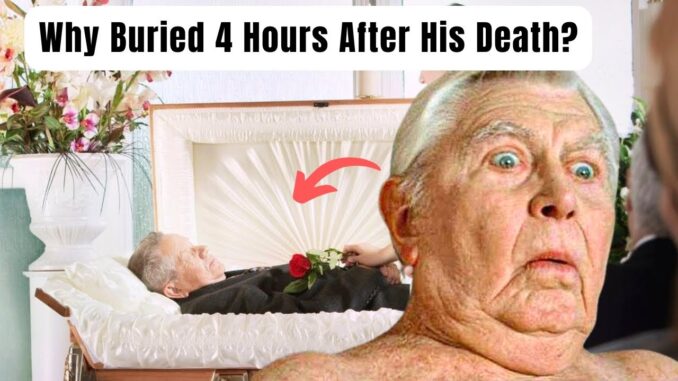
The Dust Settles Quickly: The Truth Behind Andy Griffith’s Rapid Burial
Andy Griffith, the embodiment of homespun charm and gentle authority, was a fixture in American culture for decades. From the idyllic Mayberry to the courtroom dramas of "Matlock," he projected an image of stability and quiet dignity. So, when he passed away on July 3, 2012, the nation grieved. But the collective mourning was followed by a collective surprise: just five hours after his death, Andy Griffith was buried. This abruptness, this lack of fanfare, sparked whispers, conjecture, and a fervent search for the "truth" behind the rapid burial.
While the absence of a public memorial service and the swift interment might seem unusual for a celebrity of Griffith's magnitude, the "truth" behind the matter is far less scandalous than some might have imagined. It's a truth rooted in privacy, practicality, and the wishes of a man who, despite his fame, valued the simple life he had cultivated in his beloved North Carolina.
Firstly, it's crucial to understand that Andy Griffith was a fiercely private individual, especially in his later years. He had retreated from the limelight, preferring the solace of his home and the company of his close family. He had witnessed firsthand the often-invasive and sensational nature of celebrity culture, and he had no desire for his final moments to be subjected to the same scrutiny. The rapid burial was a deliberate act of shielding his family from the media frenzy and the potential for opportunistic intrusions that often accompany a celebrity death.
Secondly, practicality played a significant role. Griffith lived on Roanoke Island, a somewhat remote location in the Outer Banks of North Carolina. Logistics, particularly given the short notice and the desire for a private ceremony, would have been complex. Transporting his body to a more accessible location for a public viewing would have required significant planning and coordination, potentially prolonging the grieving process for his family. The immediate burial eliminated these logistical hurdles, allowing them to focus solely on mourning their loss.
Perhaps the most compelling aspect of the truth lies in the wishes of Andy Griffith himself. According to his death certificate, he had expressed his desire for a swift burial, a testament to his preference for simplicity and his aversion to ostentatious displays. This desire, while surprising to some, is consistent with the image he projected: a man grounded in traditional values, content with the quiet rhythms of life, and ultimately, in control of his own narrative, even in death.
The rumors that swirled in the wake of the burial – speculation about family feuds, hidden scandals, or even conspiracies – largely missed the mark. They overlooked the fundamental human desire for privacy and the deeply personal nature of grief. They also underestimated the power of a man who, despite his fame, remained true to his roots and determined to dictate the terms of his own departure.
In conclusion, the "truth" behind Andy Griffith's rapid burial is not a sensational tale of hidden secrets. It is a story of privacy, practicality, and the enduring influence of a man who, even in death, remained committed to the values he championed throughout his life. The dust settled quickly, not to conceal a scandal, but to allow the family to grieve in peace and to honor the wishes of a man who, despite his iconic status, simply wanted to be laid to rest with the quiet dignity he deserved. The quick burial, then, is not a mystery to be solved, but a reflection of the man himself: unassuming, private, and ultimately, in control. It's a final lesson from Andy Griffith, reminding us that even in a world obsessed with spectacle, there is still value in simplicity, privacy, and the power of a personal wish.
